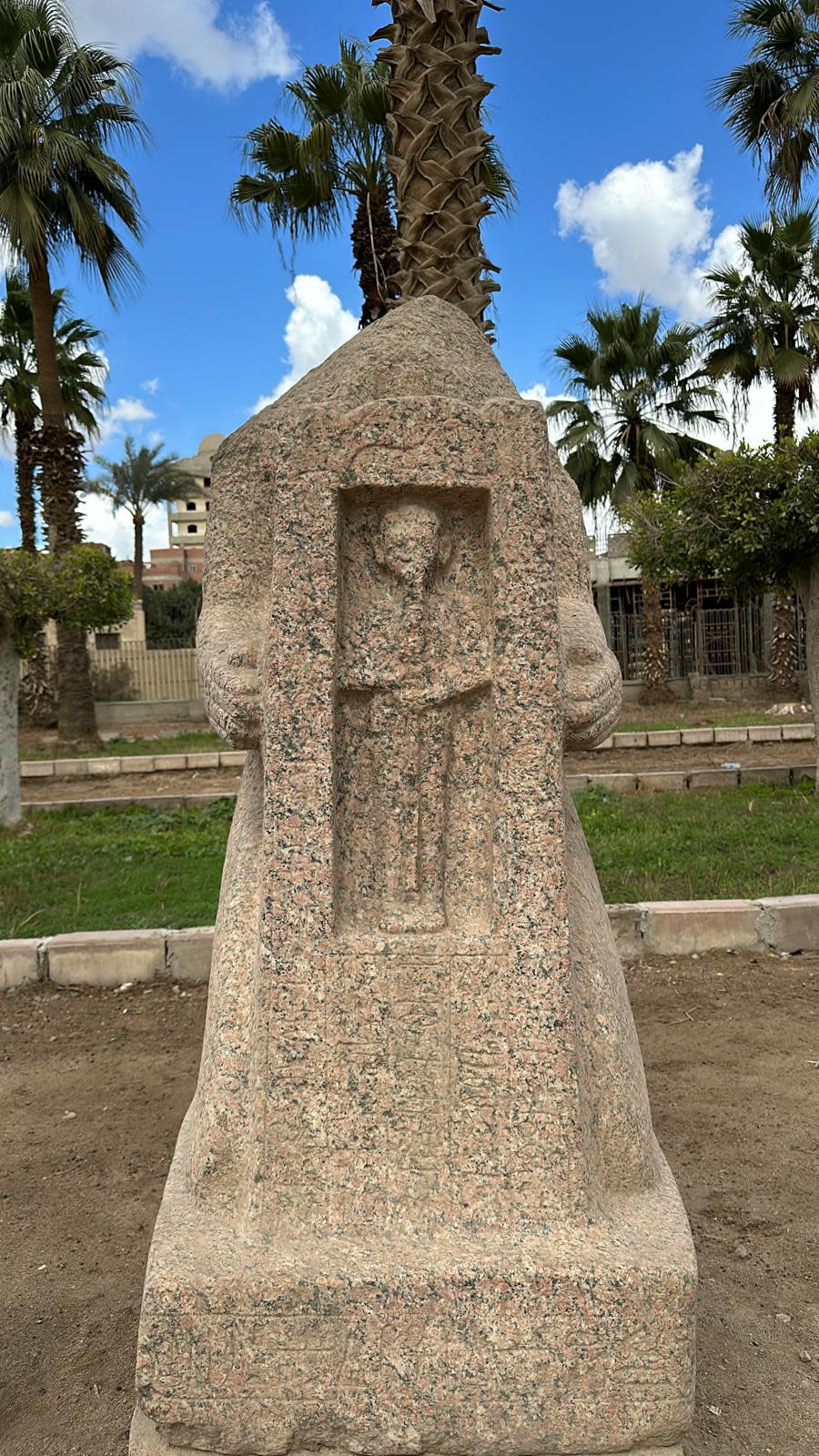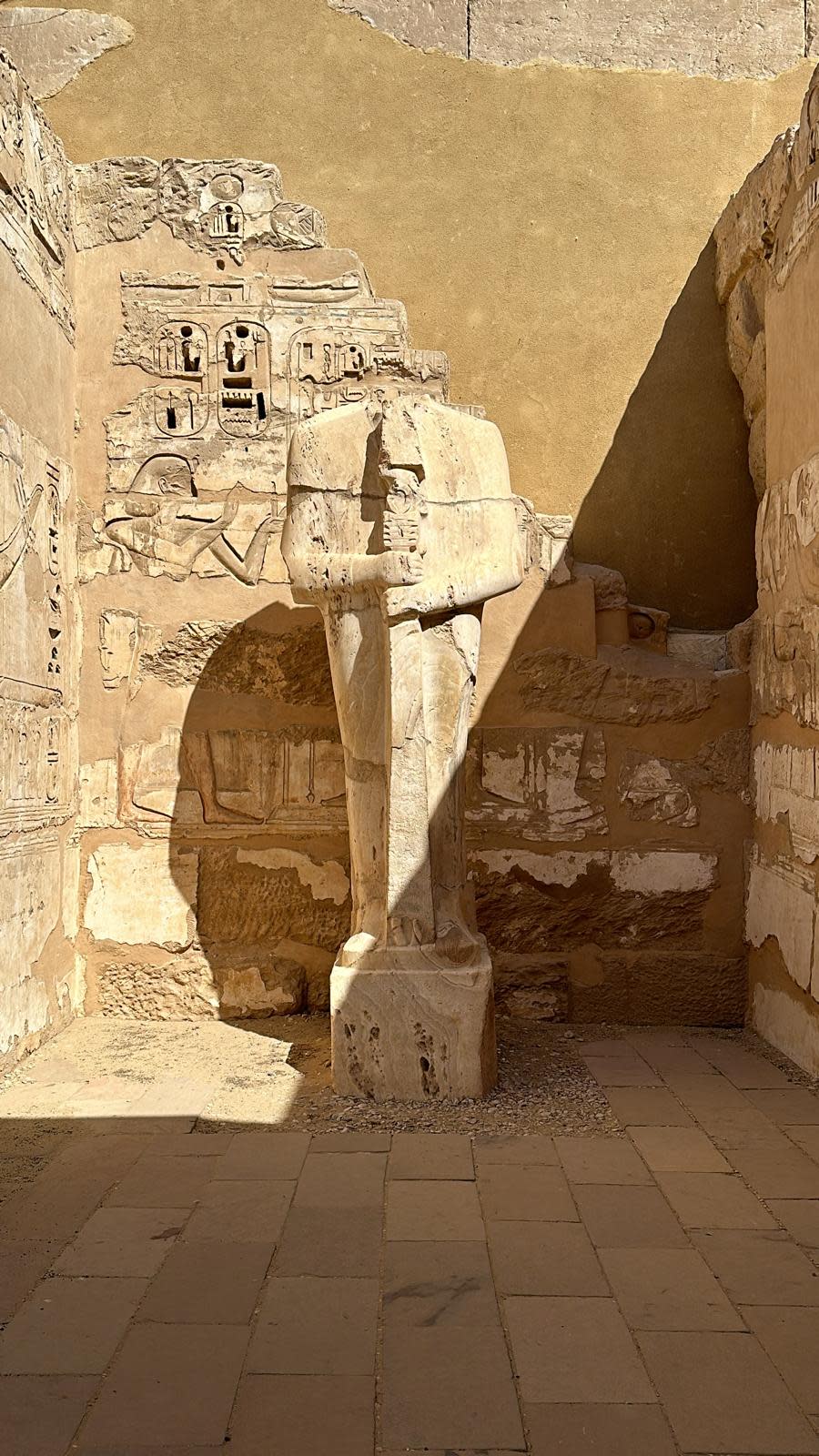Was the Oscar Statuette Modeled and Named After Ancient Egyptian Gods?
- Oops!Something went wrong.Please try again later.

On Sunday night, for the 96th time, the Academy of Motion Picture Arts and Sciences will hand out Academy Award statuettes, which many have referred to since the early 1930s, and the Academy itself has described since 1939, as “Oscars.”
The Academy has long asserted that these shiny gold figurines — which are now the world’s most iconic prizes, even more recognizable than the Nobel or Pulitzer variety — depict a knight standing erect and holding, right hand over left, a crusader’s sword (in order to defend the film industry), which pierces beneath him a reel of film with five spokes (representing the original branches of the organization, producers, actors, directors, writers and technicians).
More from The Hollywood Reporter
Lily Gladstone Recalls Being "Really Upset" When Cate Blanchett Didn't Win Oscar for 'Elizabeth'
Free Palestine March Set for Los Angeles Ahead of Oscars: "No Awards During a Genocide"
The nickname “Oscar,” meanwhile, has been variously attributed, without convincing evidence, to the Academy’s early executive director Margaret Herrick (who supposedly said it reminded her of an uncle named Oscar), actress Bette Davis (who claimed it resembled her husband Harmon Oscar Nelson) and columnist Sidney Skolsky (who was the first to refer to the statuette in print as “Oscar” because, he later wrote, he had tired of writing “gold statuette” and thought he would reference an old vaudeville joke in which a comedian would ask an orchestra leader, “Will you have a cigar, Oscar?”).
For nearly a century, these explanations have been largely accepted and repeated. But a few weeks ago, after being sent by my brother, who was on his honeymoon in Egypt, photos of ancient sculptures that look an awful lot like Oscar, I ventured down a deep rabbit-hole — from reading the minutes of early Academy meetings to consulting with Egyptologists at Ivy League universities — and have come to to believe that the true story of the statue’s design and name is probably very different.
* * *
The Academy, which was officially incorporated in 1927, was the brainchild of MGM chief Louis B. Mayer. A major motivation for its creation was to foster “harmony” in the industry in order to stave off the unionization of artists and craftsmen, and the notion of presenting “awards of merit for distinctive achievements” — “medals, prizes or whatever form of award may be decided upon” — seemed from the start like an effective way of advancing that objective.
In addition to Mayer, another of the organization’s 36 founders was MGM’s supervising art director Cedric Gibbons, an Irish-American who had worked at that studio since its founding in 1924, and would remain there until 1956. As former Academy executive director Bruce Davis notes in his excellent 2022 history The Academy and the Award, it was “Gibby” who was tasked, just two weeks after the establishment of the Academy, when he was just 37, with creating “a seal or emblem or insignia” for it. He ultimately arrived at a sketch of what is essentially the Oscar as we now know it, only two-dimensional. When he was subsequently asked to design the prize that the Academy would award each year for achievements in film, he came back with a sketch of a three-dimensional version that was approved by the board of directors.
Gibbons then hired — for just $500 — a 26-year-old Los Angeles sculptor, George Stanley, to realize his design. The statuette was completed in 1928; copies were cast in bronze by “master craftsman” Guido Nelli at the California Art Bronze Foundry, and then plated in gold; and a dozen were presented at the first Academy Awards ceremony on May 16, 1929, with Mayer and Stanley all in attendance. (Gibbons couldn’t make it.)
What has never been acknowledged by the Academy — or seemingly even noticed by anyone other than a few Egypt-focused bloggers — is that Gibbons’ statuette, from which the current model has deviated very little, looks eerily like ancient statuettes of Ptah, the Egyptian god of — wait for it — arts, crafts and trade. (The Academy declined comment for this story.)
Indeed, for literally thousands of years, Ptah has been depicted — often in gold — as a sleek figure, standing erect (perhaps even mummified, but for its arms and face) and holding in front of him, right hand over left, a staff. (“I wonder if he was influenced by Egypt, because it is very similar to the god Ptah,” artist Karon Davis recently mused to The Hollywood Reporter when sharing a reimagined statuette alongside other artists for the magazine’s Oscar issue.)
Gibbons, like everyone else who was involved in the establishment of the Academy and the design of its award, is long-deceased (he passed away in 1960), so it is probably impossible, at this point, to get a definitive answer about what influenced his design of the statuette. But, in terms of circumstantial evidence, it seems all but certain that he would have been acquainted with Ptah.
Gibbons was and remains closely associated with the Art Deco movement that exploded in the 1920s and 1930s, at a time when America was experiencing a Great Depression, but was drawn to opulence. He was exposed to the style on a 1925 trip to the Exposition des Arts Decoratifs et Industriels Modernes in Paris, and was apparently very taken with it. He soon thereafter designed in that style the home in which he lived with his first wife, the silent era movie star Dolores Del Rio, and regularly hosted Hollywood’s A-list for parties (construction started in 1929). And over the next several decades he designed, or at least oversaw the design, of countless MGM sets in that style, from the lobby of 1932’s Grand Hotel to the Emerald City of 1939’s The Wizard of Oz to the fantastical settings of Busby Berkeley’s kaleidoscopic 1930s musicals.
And Art Deco, with its geometric shapes and sleek surfaces, traces back directly to — you guessed it — ancient Egypt. In fact, the label only emerged in the 1960s. Back in the 1920s and 1930s, when Gibbons was helping to popularize it, many referred to it as “Nile Style.”
The craze traces back to 1922, when the British archaeologist Howard Carter discovered in Egypt’s Valley of the Kings the tomb of King Tutankhamun, aka “King Tut,” who reigned from around 1332 BC, when he was nine, through his death in 1323 BC, when he was 19. Unlike the tombs of most other ancient pharaohs, which had been raided by graverobbers, King Tut’s tomb was found intact and filled with more than 5,000 artifacts which were cleared and categorized over the next decade. Arguably the most significant archaeological discovery of all time, King Tut’s tomb and its contents — including statues of Ptah — received worldwide media attention, and sparked a surge in ancient-Egyptian-inspired jewelry; art; and architecture, including New York’s Chrysler Building (construction started in 1928), Empire State Building (1930), Rockefeller Center (1930) and Radio City Music Hall (1931). (Hollywood’s Egyptian Theatre had actually been in the works before the discovery of King Tut’s tomb, and opened the same year.)
Gibbons, upon being tasked by the Academy with creating a statuette to celebrate artistic achievement, decided to design it in that style, and very probably thought about other artifacts of the sort — which brings us back to Ptah. For centuries BC, Egyptians, particularly in the ancient capital of Memphis, regarded Ptah as the “creator god,” a god of artists and craftsmen. So for a designer looking to make a statuette celebrating artists and craftsmen, there could be no more appropriate model.
But what does any of this have to do with the name “Oscar”? Over the centuries, depictions of Ptah were merged with depictions of two other ancient dieties, Osiris, a god of resurrection, and Sokar, a god of the afterlife, resulting in a “funerary god” known as Ptah-Sokar-Osiris, symbolizing life, death and rebirth. Sokar alone reads awfully similar to Oscar, as does a merger of the names Osiris and Sokar. Again, this is purely speculation, but Gibbons — or anyone else who recognized the resemblance between Ptah and the Academy Award statuette — might thereby have arrived at such a nickname. Such a path is no less plausible to me than the ones claimed by Herrick, Davis or Skolsky.
* * *
Gibbons granted relatively few interviews, and, as best I can tell, never spoke in-depth about the inspiration for his most famous creation, the Academy Award. (Poetically enough, he himself was nominated for it 37 times, winning 11, though he reportedly said, “I never won an Oscar I deserved or deserved an Oscar I won.”) But today, if you visit Egyptian cities including Memphis and Luxor, or museums around the world that showcase Egyptian art, and you keep your eyes open, you will still see numerous ancient sculptures and statues that look an awful lot like Oscar.


Best of The Hollywood Reporter

